Doomier and Loopier: Why our two-party system will not – and cannot - self-correct on its own.
We need major electoral reform and we need it now. A party system problem demands a party system solution.
We are now almost four months into the second Trump administration. Each day is a reminder that our politics is stuck in a doom loop. Each day feels a little doomier and loopier.
Just 11 days ago (who can remember?), the president of the United States publicly expressed uncertainty as to whether he needed to follow the Constitution. "Don't you need to uphold the Constitution of the United States as president?" NBC's Kristen Welker asked. "I don't know," Trump replied.
The man who swore an oath to "preserve, protect and defend the Constitution of the United States" now doesn't know if he needs to uphold it?
Doomier and Loopier indeed.
And the response from fellow Republicans? Silence. Of course. Why would they push back? Things move fast. We’re already onto the next outrage.
I am old enough to remember when conservatives worked themselves into an outrage lather over Barack Obama’s supposedly “lawless presidency.” How times have changed. Or have they?
Here’s the core issue: Politics is a team sport. And once you pick your team, you stick with your team.
If there are only two teams, anything that criticizes your team helps the opposing team. And you must always remember: the opposing team is bad. Very bad! Far worse than your team, whatever the faults of your team. You must always keep that in mind. When there are only two teams, and the stakes are high, disloyalty is dangerous. Disloyalty will be punished. Winning is everything. Critical lips sink ships.
Reader, there are only two teams!
And that is the problem.
Trump keeps testing the limits. His fellow Republicans keep giving him permission to inch deeper into the abyss of authoritarianism. Like authoritarians everywhere, he keeps heightening the conflicts to escalate the fight: “Experience shows that once a movement and a people have burned the bridges behind them, they will fight more unrestrainedly than if they still had the possibility of retreat.”1
It is easier to heighten the conflicts when others on your side have nowhere else to go. In the United States two-party system, Republicans who are uncomfortable with Trump but dislike Democrats have had nowhere to go for nine years. In a two-party system, there are only two choices. They’ve had to make their peace with MAGA to keep opposing Democrats.
And that is the problem.
It is a party system problem.
And a party system problem by definition requires a party system solution.
Here’s the good news: More and more people are recognizing that this is indeed a problem. And some of them are even doing something about it. The most powerful dial we can turn right now to break the doom loop – re-legalizing fusion voting – is currently working its way through the state courts in three states: Wisconsin, Kansas, and New Jersey. (more on that further down.)
In the longer term, we need multiparty proportional representation. But fusion voting can happen sooner because litigation efforts can re-legalize it – and efforts are already underway. Proportional representation is a few years further out. By making more parties possible, fusion voting is a powerful tool to move towards multiparty democracy.
The two-party doom loop, in theory and practice
The "two-party doom loop" is in the title of my 2020 book, Breaking the Two-Party Doom Loop: The Case for Multiparty Democracy in America.
I coined it to describe an increasingly vicious cycle of escalating rhetoric around increasingly high-stakes narrow elections. As parties become more polarized, they compromise less. They demonize more. It’s tat-for-tat, escalation begetting escalation. It’s not always symmetrical. But once it gets going, there’s no backing down.
This self-reinforcing logic cuts at the foundational core of the democratic bargain — mutual toleration and forbearance. For democracy to work, parties must be able to lose elections without existential fear. This is a fragile bargain. It requires trust that winners won't abuse their powers. Winners must not make it harder for losers to compete in the future.
When this trust breaks down, the stakes of elections rise dramatically. When elections become existential, support for anti-democratic behaviors increases.
Here's the problem: when the stakes get too high, we start to reason differently. We might start believing it's acceptable if our side makes it harder for the other side to vote. We might tell ourselves the other side cheats. We might convince ourselves we need extraordinary measures to prevent their cheating.
This doom loop logic leads to a "subversion dilemma." Citizens believe their political opponents threaten democracy itself. This belief makes them willing to break democratic norms. They do this to prevent (dangerous, anti-democratic) opponents from having the chance to govern.
Doom loop politics thus undermines democracy through a cruel paradox. When we become convinced the other side is dangerous, we decide our side needs extraordinary measures to save democracy. And in doing so, we actually participate in democracy's breakdown — even as we think we're preserving it. Democracy hypocrisy, indeed.
In a 2023 survey, about 80 percent of Republicans said they did not believe the Democratic Party respected democratic institutions. About 75 percent of Democrats felt the same way about Republicans. Only about 15 percent of partisans thought the opposing party governed ethically.
In October 2024, 87 percent of voters said they believed "America will suffer permanent damage if their candidate loses."
These are the stakes that justify democratic norm-breaking.
The wishful thinking of a return to normalcy after 2020
Back in 2020, many serious people were convinced that if Trump lost the November election, the Republican Party could move on and go back to "normal." They did not believe that the doom loop was real.
Moderate Republicans clung to the fantasy that post-Trump, their party would shed its populist-authoritarian tendencies and rediscover its traditional conservative roots. I understood their reluctance to accept the doom loop—doing so would leave them politically homeless. They wanted their party back! So they tried to fight within their party, playing in some primaries. Overwhelmingly, they lost.
Most Democrats I talked with also did not want to believe in the doom loop. In 2020, they hoped that Trump's incompetence and unpopularity would indeed lead to an overwhelming and quasi-permanent victory. It did not. Democrats won unified control of government, but only barely—a 50-50 Senate and a House majority that evaporated two years later.
January 6, 2021 began to change some minds. Immediately after the storming of the U.S. Capitol, many congressional Republicans declared that they had had enough of Trump’s antics. But when the opportunity came to hold Trump to account for inciting an attack on the U.S. Capitol, few actually voted to impeach.
Why?
The simplest explanation is, as ever, the most likely one. Whatever qualms fellow Republicans might have had about Trump, he was a member of their team. Democrats were the true enemy. Anything that gave Democrats a victory was betrayal.
So Trump won the battle of the narratives. Republicans gradually updated their views to cast January 6 as no more than an innocent protest that maybe got out of hand.
The harder Democrats pushed for accountability, the more Republicans objected in reflexive opposition, rewriting history to maintain their collective status. Somehow, Trump wound up as the victim, and the rioters as martyrs, deserving emancipation when Trump returned to office. This is the doom loop in action.
Trump 47 marks the apotheosis of doom loop politics
The Republican Party of 2025 bears almost no resemblance to its pre-Trump incarnation. Almost a decade into the Trump era, the doom loop has worked its dark magic with stunning efficiency. Trump's greatest political asset? His ability to drive liberals crazy. His supporters' greatest joy? Watching him do it. This is politics as doom loop warfare.
Many Republican voters initially rejected Trump in 2016. But lacking an alternative they could support, they warmed up to him. They were Republicans, after all. Now the very meaning of "Republican" has been transformed. Yet no other viable political identities exist for voters who oppose Democrats but find themselves uncomfortable with Trumpism.
Since 2016, right-leaning politicians who found themselves at odds with the direction of the GOP faced a brutal choice. Leave politics entirely (many did). Adapt to the combative position of MAGA politics (many did). What they couldn't do was build an alternative home or identity. Our strict two-party system offers no alternative to the binary. Almost all of Trump's critics have vanished from GOP ranks or succumbed to MAGA-fication. Traditional conservative principles became luxury items in Republican politics – expensive to maintain and impossible to keep clean.
Only a handful of openly Trump-skeptic Republicans remain in Washington. For how much longer, who knows? Maine's Susan Collins is vulnerable in 2026, in a state that hasn't voted statewide for a Republican presidential candidate since 1988. Alaska's Lisa Murkowski, who lost a Republican primary in 2010 and ran as an independent, has won three times(2010, 2016, 2022) by being most Democrats' preferred candidate. And surprisingly, Mitch McConnell now offers some outspoken resistance, though he looks very much not long for this world.
Moderation does not appear to be in the GOP’s future anytime soon. A recent NBC News poll found that 56 percent of registered Republicans consider themselves more MAGA supporters than Republicans.
The Democrats lose faith in compromise
Democrats are transforming rapidly in 2025. The outrage Democratic voters now heap on their leaders mirrors the fury Republicans directed at their establishment throughout the 2010s. This marks a dramatic shift from 2017, when a decided majority of Democratic voters wanted to see some compromise with Trump to get things done. Now, two-thirds want full-on political combat.
The most popular politician in America currently? Bernie Sanders. J.B. Pritzker and Alexandria Ocasio-Cortez, who have been relentlessly hammering Trump, also enjoy enthusiastic support. Meanwhile, the Democratic Party itself and Senate Minority Leader Chuck Schumer are deep underwater in approval ratings.
As 2028 approaches, I expect Democratic presidential hopefuls to advance increasingly audacious visions, drawing inspiration from Trump's expansive exercise of executive power. If Trump can dismantle the administrative state, why couldn't a progressive president reconstruct it with enhanced authority? If Trump reshapes the courts, what prevents a progressive president from forcing retirements or expanding the judiciary?
Recent polling reveals that 56 percent of registered Democrats now identify primarily as supporters of the progressive movement rather than the Democratic Party—a perfect mirror to the 56 percent of registered Republicans who consider themselves more MAGA than Republican.
Again, this is the doom loop in action. Escalation begets escalation. There are no off-ramps for those who want off. There is either our side or their side.
I still agree much more with Democrats. And I admit, the radical actions of the Trump administration are radicalizing me in return. It’s all so dumb and cruel and destructive. I am more open to a future Democratic government dramatically remaking the country, more open than I ever have been.
Even as I write about the doom loop, I see myself as a part of it. I don’t think Democrats should compromise. I do think Democrats should fight back with everything they have.
I can recognize escalating political hardball is bad for the system. But then I think: what’s more harmful is capitulating to Republican authoritarianism. A little game theory tells me my side should definitely not back down. Much as I might wish for a better party system, I’m operating with my values in the one that we have, not the one I wish we had. In a different system, I might think and feel differently. We all might. And that is precisely my point.
Both parties are flailing, and American democracy is losing legitimacy under the doom loop
Escalating hardball makes excuses for escalating hardball. This is the doom loop. But it also damages both parties and the entire legitimacy of the political system in response. The attacks build up. Reputations get damaged. Legitimacy declines.
Consider a recent Washington Post poll, which found that only 35 percent of Americans felt the Republican Party was in touch with the concerns of most Americans. That's bad, but it's slightly better than the Democratic Party — which only 30 percent of respondents felt was in touch with the concerns of most Americans. By contrast, 39 percent of Americans felt Donald Trump was in touch. And Trump is the least popular president ever at this point in his term!
Or consider this recent NBC News Poll, which found that 38 percent of Americans felt as though neither party fights for people like them.
Pew has been tracking the share of Americans who view both parties unfavorably since 1994, when it was only 6 percent. By 2023, it was up to 28 percent. If we view the NBC poll as continuing the time series, that number is up to 38 percent now. This may be the doom loop's most dangerous product — not just hatred of the other side, but disillusionment with the entire system.
These are catastrophic numbers. A political system requires a certain amount of legitimacy to function. Right now, neither party commands anywhere close to widespread legitimacy.
The result is a legitimacy crisis where democratic institutions themselves begin to lose their foundational public support.
The logical consequence is that support for democracy in the United States is declining, somewhat uniquely among advanced democracies.
This is not a surprise: Too many Americans are looking at the political system and seeing a doom loop. If this is what democracy looks like, is it really worth supporting? This question represents the doom loop's most consequential damage — when people begin to question not just opposing parties, but the democratic framework that contains them.
The system will not self-correct. Only electoral reform can break the doom loop
There is no automatic self-correction coming for us. To save our democracy, we must target the engine driving this destructive spiral—the binary party structure itself.
We need more parties. We need better parties. We need a new party system. It's that simple. Full stop.
I've backed fusion voting and proportional representation as ways to escape our destructive binary because they nurture partisan political diversity naturally. Fresh parties create new power centers and identities. They break the us-versus-them dynamic by adding more players to the game. They restore the fluid give-and-take essential for democratic health.
So in a moment of doom and gloom, there is at least some progress to cheer.
Wisconsin, Kansas, and New Jersey all have active efforts to restore fusion voting. State supreme courts will likely rule on the Kansas and New Jersey cases before the 2026 midterms. In each state, centrist groups have formed new parties advocating for fusion as a way to voice dissent and re-orient politics without throwing their votes away.
First, a quick primer on how fusion works.
As the pro-democracy group Protect Democracy explains,
“Fusion voting refers to a process that was once universal throughout the U.S. and still features prominently in several states: more than one political party nominates the same candidate on the ballot, allowing voters to support their preferred candidate — without having to support one of the two major parties. Typically, this means a minor party and major party “fuse” together to cross-nominate and support the same candidate. A candidate’s vote total is the sum of the votes they received on each of their nominating party’s lines.”
Here’s a handy explainer graphic:
Want more? Here’s another explainer: https://centerforballotfreedom.org/about-fusion-voting/
Or if you prefer a one-minute video explainer, this is worth your time: https://www.youtube.com/watch?v=REdTJ6u77ek
Want to know why more than 120 leading scholars signed a letter in support of fusion voting? (The list includes some pretty big names in the democracy field: including Guy-Uriel Charles, Kathy Cramer, Larry Diamond, Aziz Huq, Alex Keyssar, Steve Levitsky, Jane Mansbridge, Bertrall Ross, Nick Stephanopoulos, and Larry Tribe.)
I could keep going. But instead I’ll share what Dale Schultz and Dave Mahoney, co-founders of the new United Wisconsin Party (and the former Republican State Senate Majority Leader and former Democratic Dane County Sheriff, respectively) wrote as they launched United Wisconsin:
“Instead of working together around Wisconsin values and traditions which have made the state such a great place to call home, too many elected officials have become mired in a morass of divisions that erode trust and make it nearly impossible to tackle the issues that matter most to the people of Wisconsin. United Wisconsin and fusion voting would give voters who feel intensely dissatisfied with our rigid and unstable two-party system more electoral choices and empower ideas and voters who do not fit neatly into red or blue boxes…
United Wisconsin’s platform revolves around four core values that form the bedrock of our state’s success:
The rule of law.
Public education.
Small business.
Conservation of our natural resources.
These priorities were once promoted by nearly all our political representatives, regardless of their political party. With fusion voting, we voters can send a strong electoral message that our priorities need to be addressed and cannot be ignored.
They have filed a lawsuit to make fusion legal again in Wisconsin. As have the other new party formations in New Jersey and Kansas. In all three states, these new parties want to clarify a political cost when major party candidates move to the extremes and disregard the rule of law. By organizing a new moderate identity around a new political party with the power of a ballot line, these parties could tip the balance of forces back towards the political center and break the two-party doom loop.
In short: If state courts restore fusion voting, they'll deliver a serious blow to the two-party doom loop. These wins would let new parties reshape our conflicts along less catastrophic lines.
And who knows? Maybe a 2028 presidential hopeful will pick up on the growing energy and champion electoral reform as part of a platform. When most Americans feel alienated from both major parties, what could connect more powerfully than breaking this destructive two-party doom loop once and for all?
That was Joseph Goebels, from spring 1943, as quoted in Frank Trentmann’s insightful book, Out of the Darkness: The Germans, 1942-2022, p. 70.




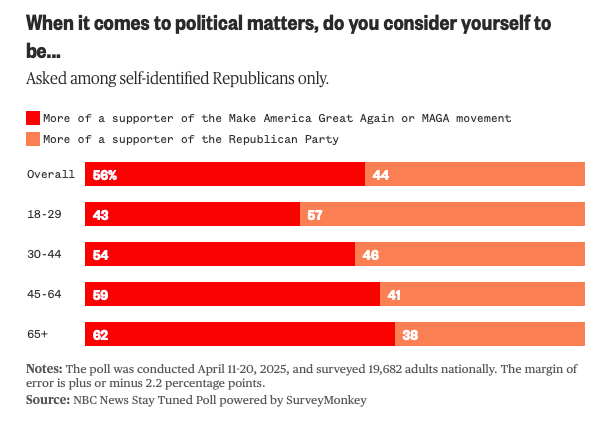

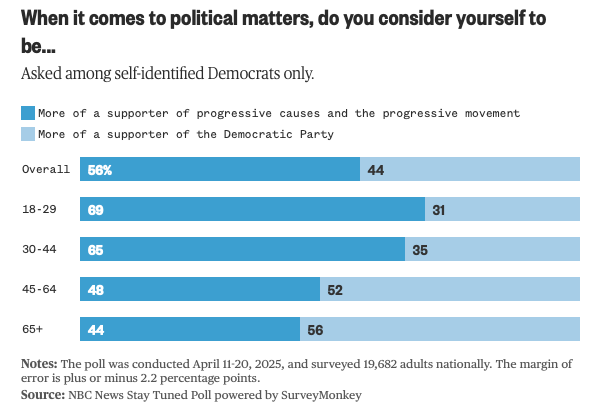



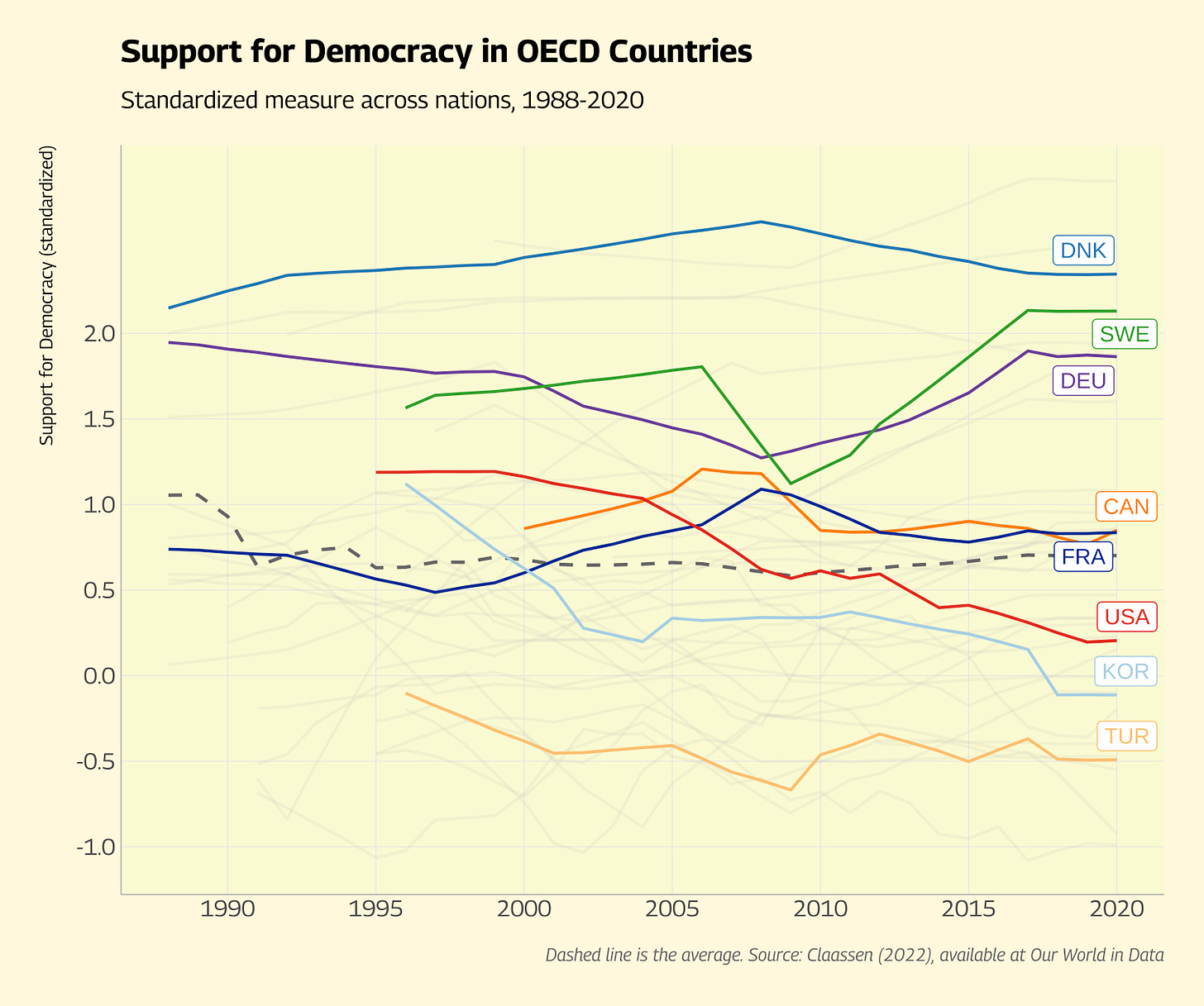
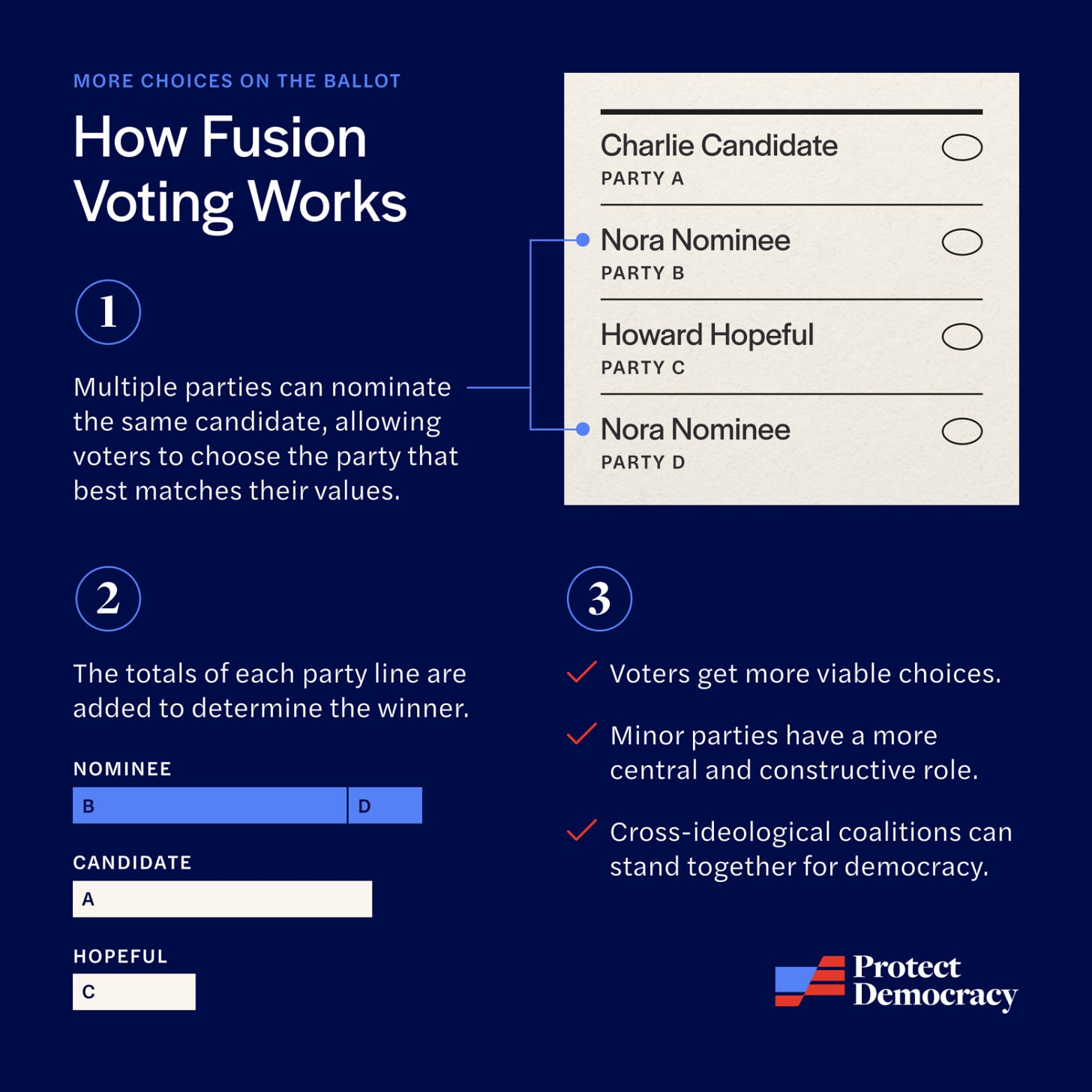
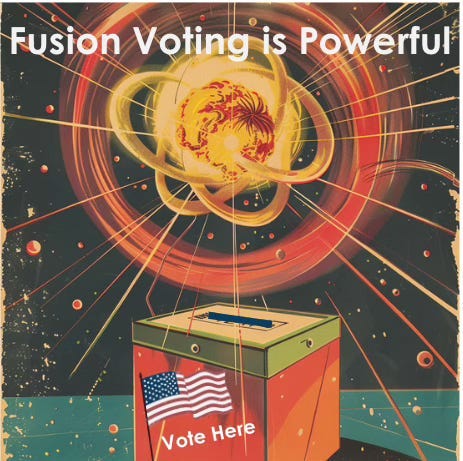

I'm all for fusion voting, but I (still) don't see how it makes a significant difference. So I can vote for Nora Nominee on the Party B line, or the Party D line. Either way, it's one vote for Nora, which she was going to get anyway. The election result doesn't change at all. What am I missing?
Look, the two party system has offered two choices the past ten years—incompetent fascism or semi competent party politics. This is as plain as day. The “system” may be flawed, but with such a stark and obvious choice, the problem is that we have a substantial subset of Americans who think incompetent fascism is the better choice.
People have agency. The GOP doesn’t force its voters to absorb its fascist propaganda or to have their precious feelings constantly hurt by liberals. Nor does it cause “conservatives” to be so ideologically blinded that they consider anything liberal a socialist enterprise.
There are lots of potential solutions to voters choosing fascism. Yours may be one, but it’s certainly not obvious. Parliamentary democracy in Israel has resulted in a perhaps even more insidious form of fascism than our two party system has, and it’s still possible European democracies tilt this way, too, just like Hungary, Poland, and Czechia have. So if you want to claim you have the solution to what ails our democracy, you need to address the fascist elephant in the room.